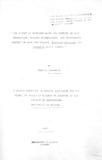| dc.contributor.author | Kanampiu, F K | |
| dc.date.accessioned | 2013-05-10T12:54:17Z | |
| dc.date.available | 2013-05-10T12:54:17Z | |
| dc.date.issued | 1987 | |
| dc.identifier.citation | kanampiu, F.K(1987). The effect of nitrogen rates and sources on leaf production, nitrate accumulation. and thiocyanate content in kale and collard (Brassica Oleracea var. Acephala, D.C.) leaves | en |
| dc.identifier.uri | http://erepository.uonbi.ac.ke:8080/xmlui/handle/123456789/21423 | |
| dc.description | Msc- Thesis | en |
| dc.description.abstract | Two experiments were conducted between August
1986 and March 1987 at the Field Station of
Faculty of Agriculture, Kabete Campus, University
of Nairobi, to study the effect of rates and sources
of nitrogen (N) on leaf production, thiocyanate
content and nitrate accumulation in leaves of 'Thouand-
headed ' kale and 'Georgia' colIards (both Brassica
oleracea var. acephala D.C.). Four N rates (0,
l0, 20 and 40 grams (g) per plant) and two sources
(calcium ammonium nitrate-CAN and sulphate of ammonia-
SA) were used.
Leaf yield was assessed by both cumulative
2 leaf weight per 10 m and leaf number per plant.
The leaf yield jncreased as rates of N increased.
Plants top-dressed with higher rates of N than 10 g
per plant did n~t show significant increase in leaf
weight. Nitrogen sources had no significant effect
on leaf yield. However, varietal effect on lear production
was significant. 'Georgia' collards gave
significantly higher leaf yield than 'Thousandheaded'
kale did. Interactions between N rates and
varieties on leaf weight and N sources and varieties
on leaf number were significant during the second
experiment. Interaction between N rates, sources
during the second experiment.
Nitrate-nitrogen (N03-N) in the leaves increased
with increasing rates of N fertilizer application.
Leaves from plants top-dressed with
CAN accumulated more N0
-N than those top-dressed
with SA. Leaves of 'Thousand-headed' kale accumulated
significantly higher N03-N than those of
'Georgia' collards. Interaction between rates and
sources of N on N03-N accumulation in leaves was
significant during the first harvest of second experiment.
The results also show that there was a positive
correlation between N03-N in the soil and
N03-N in leaves at harvest time and that petioles
accumulated more.N~3-N than laminae.
Nitrogen rates had no significant effect on
thiocyanate ion (SCN-) content in leaves. However,
the effect of N sources on SCN content was significant.
Leaves from plants top-dressed with SA yielded
significantly higher SCN than those top-dressed
with CAN. Leaves of 'Thousand-headed' kale yielded
significantly higher SCN than did those of 'Georgia'
collards. Interaction between rates and sources of
N on SCN content in leaves was significant. 1n t c raction
between N sources and varieties 011 SCN con
tent in leaves was significant during second harvest
011 both experiments. | en |
| dc.description.sponsorship | University of Nairobi | en |
| dc.language.iso | en | en |
| dc.subject | Nitrogen rates | en |
| dc.subject | Leaf production | en |
| dc.subject | Nitrate accumulation | en |
| dc.subject | Thiocyanate content | en |
| dc.subject | Collard (Brassica Oleracea var. Acephala, D.C.) | en |
| dc.title | The effect of nitrogen rates and sources on leaf production, nitrate accumulation. and thiocyanate content in kale and collard (Brassica Oleracea var. Acephala, D.C.) leaves | en |
| dc.type | Thesis | en |
| local.publisher | Department of soil science, University of Nairobi | en |

